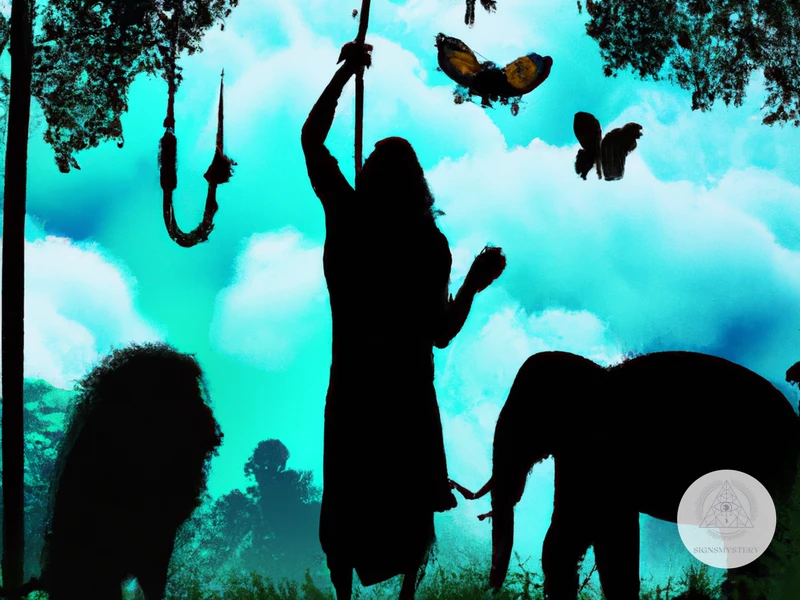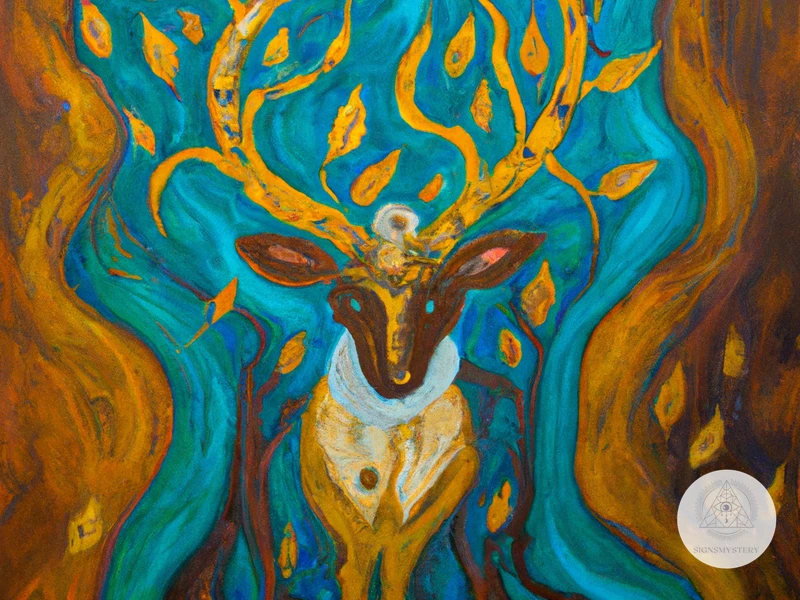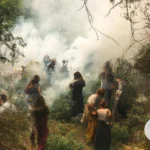Shamanic beliefs have been integral to cultures across the world for thousands of years. These beliefs have influenced traditions, healing practices, and environmental conservation efforts. As we continue to face challenges in preserving our planet’s biodiversity, understanding the intersection of shamanism and conservation becomes increasingly important. This article will explore the impact of shamanic beliefs on wildlife conservation, providing examples from around the world, examining the positive and negative impacts of shamanic practices, and discussing controversies and the role of education and collaboration in the future of shamanism and conservation.
Shamanic Beliefs and Wildlife Conservation

Shamanic beliefs have a deep influence on wildlife conservation efforts, as many indigenous cultures around the world have spiritual connections with the animal world. According to shamanic belief, animals are often perceived as spiritual guides, and their well-being is intricately connected to human survival. The holistic worldview of shamanism sees all living beings as interconnected, and damage to one aspect of nature affects the whole. In some shamanic cultures, the ritual use of animals is an important part of their spiritual practices, which can raise ethical concerns in wildlife conservation. However, many shamanic communities have developed conservation efforts based on their spiritual connections to nature, with a focus on preserving animal populations and their habitats. The intersection of shamanism and wildlife conservation creates unique opportunities and challenges, which require collaboration and education to find sustainable solutions for protecting our planet’s biodiversity.
Understanding Shamanism
Shamanism is a spiritual practice that has been around for thousands of years. It is based on the belief that everything in the world – living and non-living – has a spirit and connects humans to the natural world. In shamanic cultures, animals often play a significant role in spiritual practices.
One key aspect of shamanism is the use of altered states of consciousness to communicate with the spirit world. This can be achieved through various methods, such as dancing, chanting, or ingesting plant medicines.
Shamanism is also characterized by the use of traditional healing practices to address physical, emotional, and spiritual maladies. It is believed that shamans have the ability to perceive and manipulate the spirit world to bring about healing for individuals or the community.
Animal communication is another vital component of shamanism. Shamans believe that animals possess wisdom and can provide insight and guidance to humans. In many shamanic cultures, specific animals hold particular significance in spiritual practices. For example, in Native American shamanism, the eagle represents spirit and the ability to see from a higher perspective.
Understanding shamanism requires recognizing the interconnectedness of all things, including animals. For shamans, animals hold a sacred place in the natural world and are to be respected and honored. By acknowledging the spiritual significance of animals in shamanic practices, we can start to appreciate the impact of shamanism on wildlife conservation efforts.
Internal link: animals in shamanism
Conservation Efforts
Conservation efforts are actions taken to protect and preserve the natural environment, including its wildlife, habitats, and ecosystems. These efforts are critical to prevent the extinction of endangered species and to maintain the delicate balance of our planet’s ecology. When it comes to shamanic beliefs and wildlife conservation, it is imperative to examine how shamanic traditions and practices have impacted conservation efforts.
Shamanic beliefs and practices are often intimately connected to the natural world and the animals that inhabit it. Many indigenous cultures regard animals as spiritual beings, and shamanic practices involve invoking the aid and guidance of animal spirits. This special relationship between humans and animals has contributed to various conservation efforts around the world.
In some cultures, there are taboos and restrictions against the hunting or killing of certain animals. For example, in some Native American cultures, the bald eagle holds great spiritual significance, and it is illegal to harm or disturb their nests. Similarly, in Hinduism, cows are regarded as sacred, and the slaughter of cows is prohibited in many regions.
Shamanic practices often involve healing and caring for animals. This has led to the development of animal sanctuaries and rehabilitation centers around the world. For instance, many shamans in South America have created sanctuaries for orphaned animals and have worked to reintroduce them into the wild. They also educate their communities about the importance of conservation and protecting endangered species.
However, shamanic beliefs can also be at odds with conservation efforts. For instance, some shamanic practices involve the use of animal parts for spiritual or medicinal purposes. This has led to an illegal trade in animal products and has contributed to the decline of many species, such as elephants and tigers.
It is important to note that not all shamanic practices involve the use of animal products, and many shamans are actively working to promote ethical and sustainable practices. There are various organizations that seek to reconcile shamanic beliefs with conservation efforts and animal welfare, such as the Animal Community of Shamanism.
Shamanic beliefs and practices have had both positive and negative impacts on wildlife conservation efforts. It is crucial to continue to examine the complex relationship between shamanism and conservation and to work towards ensuring that conservation efforts are not impeded by harmful or unsustainable practices.
The Intersection of Shamanism and Conservation
Shamanism and conservation may seem like two entirely separate concepts, but there is an intersection where these ideas meet. This intersection occurs in the belief that ethical animal use is possible and that animals are spiritual beings deserving of respect. This belief is held by many peoples who practice shamanism.
Shamanism is known for its focus on the interconnectedness of all living beings. Working with the environment and its living beings is a significant part of shamanic practice. It is not surprising that those who practice shamanism often feel a connection to the natural world and animals. This connection becomes a driving force that motivates shamans and their communities to take action to protect and preserve the environment and its inhabitants.
Shamans believe that animals have spiritual qualities and that this spirituality demands respect, whether through ethical treatment in captivity or giving them a dignified death. When animals are treated inhumanely, it is believed that the spirits of the animals become restless, leading to negative effects on the entire community and environment.
Some shamans also believe that animals have their own language, which can be understood through deep meditation or trance states. This belief leads to a deeper appreciation and understanding of animals, which fosters a sense of responsibility to protect and conserve them.
The intersection of shamanism and conservation is centered on recognizing and respecting the spiritual aspects of all living beings, including animals. Through this recognition, shamans and their communities are motivated to work actively toward environmental conservation and the protection of vulnerable wildlife populations, leading to a positive impact on the planet and its sustainable future.
Examples of Shamanism and Conservation
Shamanism and conservation can intersect in various ways, providing unique solutions to protect wildlife. In North and South America, indigenous peoples often integrate shamanic practices into their conservation efforts. For example, in the Amazon, shamans use healing techniques to treat injured animals and help prevent further damage to the ecosystem. In Africa, the Maasai tribe practices shamanic animal reincarnation, which honors the spirit of deceased animals and encourages protection of their species. In Australia, Aboriginal communities incorporate animal-based shamanism to establish a deep spiritual connection with wildlife and instill a sense of responsibility to protect them. These examples showcase the potential impacts of shamanism on wildlife conservation and the importance of honoring indigenous knowledge in conservation efforts.
North and South America
North America: The indigenous people of North America have a long history of shamanic practices that emphasize the interconnectedness of all living things, including animals. For example, the Navajo tribe in Arizona participates in the Animal Blessing Ceremony to honor and pray for the well-being of animals. In Alaska, the Yupik shaman tradition involves working with animals in various ways, including asking for their aid in hunting and healing.
South America: In South America, the Ayahuasca ceremony is a well-known shamanic practice that involves drinking a plant-based brew to induce hallucinations and connect with spirits. The ceremony is often used for healing and personal growth, but it also has implications for wildlife conservation. In the Peruvian Amazon, shamans work with the ayahuasca vine to connect with animal spirits and understand the needs and behaviors of the local fauna. Additionally, some indigenous tribes in Brazil, such as the Yanomami, have a strong belief in animal-based shamanism, where the souls of animals and humans are believed to be interconnected and can be reincarnated into one another.
Shamanic practices in North and South America have a strong emphasis on respect and communication with animals, which can have positive impacts on wildlife conservation efforts. However, it is important to consider the potential negative impacts of traditional practices, such as hunting, on local animal populations.
Africa
has a rich history of shamanism and wildlife conservation efforts. One example of animal-based shamanism in Africa is the use of animal-based medicines in traditional healing practices. However, the use of these medicines has also led to over-hunting and poaching of certain animal species, such as rhinoceros and elephants, which has threatened their populations.
Other conservation efforts in Africa incorporate shamanic beliefs and practices. For instance, the Zulu people in South Africa have long revered the white rhinoceros as a sacred animal, believing it is a messenger and protector of their ancestors. This belief has motivated the community to engage in efforts to protect the white rhino from poaching and habitat destruction. Similarly, the Maasai people in Kenya have developed conservation efforts for lions, which they consider to be an important part of their cultural heritage and spiritual beliefs.
Despite these positive impacts, there have also been controversies surrounding the intersection of shamanism and wildlife conservation in Africa. Some conservationists have raised concerns about the potential exploitation of shamanic practices by poachers, who may use traditional beliefs to justify their illegal activities. Additionally, some organizations have criticized the use of animal parts in traditional medicine as contributing to the depletion of certain species.
To address these issues, there have been efforts to promote education and collaboration between traditional healers and conservationists. In some areas, traditional healers and conservationists have come together to develop sustainable practices that incorporate traditional beliefs and knowledge. Through open communication and mutual understanding, these efforts aim to ensure the protection of both wildlife and cultural heritage in Africa.
Australia
Australia is a vast and diverse continent, home to a rich array of wildlife. The indigenous people of Australia, known as Aboriginal Australians, have a strong connection to the land and its creatures, and their shamanic practices reflect this.
One example of shamanic beliefs influencing conservation efforts in Australia is the use of fire-stick farming. This is a traditional practice that involves using controlled fires to clear dry vegetation and promote new growth. This technique has been used by Aboriginal Australians for thousands of years to manage the land and prevent wildfires. In recent years, it has been recognized as an effective technique for reducing the risk of wildfires in areas prone to bushfires.
Another example of shamanic beliefs impacting conservation efforts in Australia is the use of totem animals. Totem animals are believed to be spiritual guides that protect and guide individuals and communities. In some cases, they are also believed to represent certain species of animals. This belief has led to the creation of totem parks, which serve as both cultural and educational centers where visitors can learn about the totem animals and their habitats.
However, there have also been controversies surrounding the use of animal-based shamanism in Australia. The use of animals in traditional practices, such as animal sacrifice, has been controversial and has come under scrutiny from animal welfare organizations. Despite this, many Aboriginal Australians continue to practice their traditional beliefs, and there is ongoing dialogue and collaboration between the indigenous communities and wildlife conservation organizations to find ways to promote conservation efforts while respecting cultural traditions.
The intersection of shamanic beliefs and wildlife conservation efforts in Australia highlights the complex relationship between cultural beliefs and conservation efforts. It also underscores the importance of education and collaboration in creating positive change for both wildlife and indigenous communities.
Asia
is home to a rich diversity of shamanic traditions and practices that have varying relationships with wildlife conservation efforts. Some shamanic practices in Asia, such as those found in Mongolia, emphasize the importance of protecting and respecting nature. The shamanic practitioners, known as Böö, traditionally work as intermediaries between humans and spirits, including the spirits of animals. They view animals as sacred and believe that the spirits of animals can offer guidance and healing to humans. The Böö maintain their connection with nature through rituals, ceremonies, and offerings to the spirits of the land. This connection with nature and the spirits of animals encourages conservation efforts, such as protecting sacred sites and respecting the natural environment.
On the other hand, some shamanic practices in Asia, such as those found in parts of China and Southeast Asia, involve the use of animal-based shamanism, which has been identified as a conservation concern. Animal-based shamanism involves the use of animal parts and products in shamanic rituals and beliefs. The trade in animal parts and products has resulted in the decline of certain species, including tigers, rhinoceros, and pangolins.
In India, shamanic practices are mainly found among tribal groups. These practices are often associated with hunting and resource use, which can have negative impacts on wildlife populations. However, efforts have been made to incorporate traditional knowledge into conservation efforts. For example, in the Nagaland region of India, the state government has worked with local communities to establish a conservation reserve for the Hoolock Gibbon, a species considered sacred by some of the tribal groups in the area. The reserve is managed in collaboration with local communities, incorporating traditional knowledge and practices into conservation efforts.
Shamanic traditions in Asia have varying relationships with wildlife conservation efforts. While some practices promote conservation through an emphasis on the importance of protecting and respecting nature, others can have negative impacts on wildlife populations through the use of animal products and practices associated with hunting and resource use. However, efforts are being made to incorporate traditional knowledge into conservation efforts in some areas of the region.
The Impact of Shamanic Practices on Wildlife Conservation

Shamanic practices have had both positive and negative impacts on wildlife conservation efforts. On the positive side, shamanistic beliefs have been used to protect and conserve ecosystems and wildlife habitats. For example, in the Amazon basin, the shamans have long believed that certain plants and animals have sacred powers and must be protected. This has led to the creation of traditional protected areas called “tunchi” forests. On the negative side, some shamanistic practices involve the use of wildlife in rituals or for medicinal purposes, which can lead to the overexploitation of certain species. Additionally, there
Subscribe to Our Newsletter
Sign up to receive the latest news and updates.
Positive Impacts
Positive impacts of shamanic beliefs on wildlife conservation efforts are numerous and profound. Some of the major ways that shamanism can contribute positively to conservation efforts are:
- Traditional Ecological Knowledge: Shamanic communities are often deeply knowledgeable about their local ecosystems, having lived and interacted with them for generations. This Traditional Ecological Knowledge (TEK) can provide valuable insights into the behavior and needs of wildlife, as well as the impact of human activities on ecosystems. This knowledge can be key to developing effective conservation strategies that take into account the needs and realities of both wildlife and human communities.
- Spiritual Values: Shamanic traditions often place great spiritual value on certain animals or natural spaces. For example, some cultures believe that certain animals are sacred, or that certain forests or mountains are the dwelling places of powerful spirits. This spiritual reverence for nature can motivate people to conserve these resources for their own sake, rather than just for practical or monetary reasons.
- Traditional Practices: Many traditional shamanic practices also have ecological benefits. For example, certain plant-based remedies and medicines can help to sustainably manage local resources and heal ecosystems that have been damaged by human activities.
- Community Involvement: Shamanic communities often have strong social structures and community values that can be leveraged to promote conservation efforts. For example, community-based conservation programs that involve local people in monitoring and protecting wildlife have been successful in many parts of the world.
The positive impacts of shamanic beliefs on wildlife conservation efforts highlight the importance of incorporating diverse perspectives and knowledge systems into conservation efforts. By valuing and incorporating traditional ecological knowledge, spiritual values, and traditional practices, we can develop more effective and sustainable conservation strategies that benefit both wildlife and human communities.
Negative Impacts
While the positive impacts of shamanism on wildlife conservation are commendable, it is also essential to note the negative impacts that can arise from traditional practices. One of the negative impacts of shamanism on wildlife conservation is the over-exploitation of resources.
Over-Exploitation of Resources
Shamanistic practices have a deep-rooted belief in ritualistic hunting and the utilization of natural resources for medicinal purposes. This belief often leads to hunting of endangered or protected species, poaching, and smuggling of rare species. The body parts of these animals are then used for traditional medicines, jewelry, and cultural artifacts. The over-exploitation of resources can lead to a reduction in biodiversity, which can harm the overall ecosystem.
Disregard for Scientific Evidence and Data
In some cases, shamanistic practices can be resistant to scientific evidence and data, which can impede conservation efforts. The traditional practices and taboos associated with shamanism can make it difficult for conservation organizations to work with local communities to protect endangered species. This can lead to conflicts between conservation efforts and traditional beliefs.
Obstruction of Traditional Conservation Efforts
Shamanistic practices can also obstruct traditional conservation efforts. For example, some tribes in the Amazon Rainforest are against the creation of national parks, as the creation of these parks would restrict access to traditional hunting grounds. This conflict can lead to environmental degradation and loss of biodiversity.
While shamanism can have positive impacts on wildlife conservation, it is essential to consider the negative impacts to ensure that conservation efforts are successful. Conservation organizations need to work together with local communities to create solutions that respect traditional practices while also protecting the ecosystem and endangered species.
Controversies in Shamanism and Conservation
Controversies in Shamanism and Conservation arise when shamanic practices conflict with modern conservation efforts, or when shamans themselves engage in unsustainable practices. Some conservationists have accused shamans of using their traditional knowledge as a cover for illegal poaching, or of profiting from the commercial trade of endangered species. Additionally, some conservation efforts have disrupted traditional shamanic practices by restricting access to sacred sites or traditional hunting grounds.
However, many indigenous groups argue that conservation efforts often ignore their role in protecting their own ecosystems, and fail to recognize the value of traditional practices in maintaining biodiversity. Indigenous communities also criticize some Western conservation efforts for prioritizing wildlife preservation over the well-being of local communities.
Another controversy has been the use of shamanic practices in animal testing. Some scientists believe that traditional remedies sourced from plants or animals could hold the key to developing new medical treatments or cures. However, others argue that using animals for experimentation is unethical, and that these practices are often exploitative and culturally insensitive.
Ultimately, the controversies surrounding shamanism and conservation stem from a clash between modern, scientific approaches and traditional cultural practices. It’s important for conservationists to recognize the value of traditional knowledge, and to collaborate with local communities in developing sustainable solutions. At the same time, it’s crucial to ensure that these practices do not contribute to the destruction of ecosystems or the exploitation of endangered species.
The Role of Education and Collaboration
Collaboration between shamans and conservation scientists is crucial in finding effective solutions to wildlife conservation issues. However, collaboration is only possible if both parties have a good understanding of each other’s needs, beliefs, and practices. Education is an essential tool in achieving this understanding.
One of the key challenges in promoting collaboration between shamans and conservation scientists is the language barrier. Many shamans speak local dialects or languages that are not widely spoken, making it difficult for scientists to communicate with them. This is why it’s important to have local intermediaries who can translate and facilitate communication between both parties.
Education can play a vital role in dispelling myths and misconceptions around shamanism. Many conservation professionals may be skeptical about shamanic practices and their efficacy in wildlife conservation efforts. Educating them about shamanism and its role in local cultures can help them better understand the context and appreciate the role of shamans in conservation.
On the other hand, providing education to shamans about modern conservation practices can help them understand the impact of certain activities on wildlife and ecosystems. Many shamans may not be aware of the negative consequences of practices such as hunting or habitat destruction. Providing them with this knowledge can help them make more informed decisions that benefit both their culture and the environment.
Collaborative education initiatives can have a significant impact on conservation efforts. For example, the South African San Institute (SASI) has been collaborating with researchers and conservation practitioners to develop collaborative models of indigenous knowledge. By documenting and sharing knowledge about San culture, including their shamanic beliefs and practices, scientists and conservationists have gained a deeper understanding of the important role shamans can play in wildlife conservation efforts.
Education and collaboration are essential tools for promoting effective conservation efforts that respect the beliefs and traditions of local cultures. By fostering a deeper understanding between shamans and conservation professionals, we can work together to find meaningful solutions that benefit both people and wildlife.
The Future of Shamanism and Conservation
The future of shamanism and conservation is uncertain, but there are actions that can be taken to improve the situation. Here are some potential scenarios for the future of shamanism and conservation:
- Increased Collaboration: Collaborations between conservation groups and indigenous communities can lead to greater mutual understanding and success in conservation efforts. By working together on projects, all parties involved can learn from each other and create more effective strategies.
- Continued Tension: There may also continue to be tensions between conservation groups and indigenous communities over the use of resources. The challenge will be to find solutions that balance the needs of both groups.
- Shamanism in the Modern World: As the modern world continues to encroach on traditional societies, the practice of shamanism may become less common. The loss of traditional cultural practices can have negative impacts on conservation efforts and biodiversity.
- Increased Education: Education programs that promote the value of traditional practices and the importance of conservation can help to bridge the gap between traditional communities and conservation groups. By increasing awareness and understanding, these programs can promote more effective strategies.
It is important to note that the future of shamanism and conservation will depend on a variety of factors. Factors such as climate change, political stability, and economic growth will all play a role in shaping the future of conservation efforts. However, one thing is clear: collaboration and education will be key to success. By learning from each other and working together, conservation groups and traditional communities can create a brighter future for wildlife and their habitats.
Conclusion
As we conclude our discussion on the impact of shamanic beliefs on wildlife conservation efforts, it becomes clear that there are both positive and negative impacts of shamanic practices on conservation. While shamanism can help to protect wildlife by creating a sense of reverence and respect for nature, it can also perpetuate harmful beliefs and practices that lead to the exploitation and destruction of the natural world.
It is important for conservationists and practitioners of shamanism to collaborate and educate each other in order to find a balance between preserving cultural traditions and protecting the environment. Through continued dialogue and mutual understanding, we can work towards a future where shamanic beliefs and conservation efforts can coexist and complement each other.
In addition to collaboration and education, it is also important for individuals to take action in their own lives and communities. This can be as simple as reducing plastic consumption, supporting sustainable and ethical wildlife tourism, and advocating for policies that protect wildlife and their habitats.
Finally, it is essential to recognize and acknowledge the complexities and controversies surrounding the intersection of shamanic beliefs and wildlife conservation. It is not a simple or straightforward issue, and it requires ongoing investigation, understanding, and empathy from all parties involved.
In summary, shamanic beliefs can have a significant impact on wildlife conservation efforts, both positive and negative. By promoting collaboration, education, and individual action, we can work towards a future where cultural traditions and environmental protection can thrive in harmony.
Frequently Asked Questions
What is shamanism?
Shamanism is an ancient practice that involves the use of spiritual rituals, healing ceremonies, and communication with the spiritual world.
How do shamanic beliefs impact wildlife conservation?
Shamanic beliefs can impact wildlife conservation efforts in both positive and negative ways, depending on how they are applied.
What are some positive impacts of shamanic practices on wildlife conservation?
Shamanic practices can help promote a sense of reverence and respect for nature, encourage conservation efforts, and provide guidance for sustainable resource use.
What are some negative impacts of shamanic practices on wildlife conservation?
Shamanic practices can also lead to over-exploitation of resources, reinforce unsustainable cultural practices, and contribute to the illegal wildlife trade.
Are there any controversies surrounding shamanism and conservation?
Yes, there is ongoing debate about whether shamanic practices are compatible with modern conservation efforts, and whether indigenous communities should have a greater say in wildlife management policies.
Can shamanic beliefs be integrated into modern conservation strategies?
Yes, many conservation organizations are working with indigenous communities to integrate traditional ecological knowledge and practices into their conservation strategies.
What are some examples of successful conservation efforts that incorporate shamanic beliefs?
Examples include the establishment of community-led protected areas, the use of traditional ecological knowledge to guide conservation policies, and efforts to link conservation and sustainable development.
What role does education play in promoting the integration of shamanic beliefs and conservation?
Education can play an important role in promoting greater understanding between different cultures and helping to bridge the gap between traditional and modern conservation practices.
How can collaboration between indigenous communities and conservation organizations be improved?
Collaboration can be improved by ensuring that indigenous communities have a greater say in conservation policies, that conservation efforts are aligned with traditional values and practices, and that indigenous voices are represented at all levels of decision-making.
What does the future hold for shamanism and wildlife conservation?
The future is uncertain, but there is growing recognition of the importance of traditional ecological knowledge and the need for greater collaboration between indigenous communities and conservation organizations.










